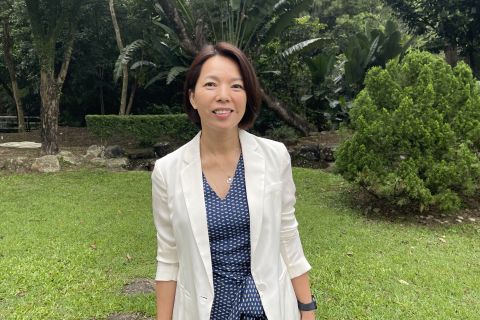
By Alistair Jones
SMU Office of Research – “I see moving to Singapore as an exciting opportunity to extend my research program beyond the United States and develop new work on the urban environmental challenges facing Asian cities,” says Sayd Randle, who recently joined Singapore Management University (SMU) as an Assistant Professor of Urban Studies in the College of Integrative Studies.
Professor Randle's research focus is on the spatial and cultural politics of urban climate adaptation. She recently published a case study based on field work she conducted on a green infrastructure pilot project in a residential area of Los Angeles (LA).
Green infrastructure, in an urban water-management context, is defined by the US Environmental Protection Agency (EPA) as infrastructure that “uses vegetation, soils, and other elements and practices to restore some of the natural processes required to manage water and create healthier urban environments”.
Since the 1970s, the benefits to humans from cultivating and employing environmental assets have been known as ecosystem services.
The idea became more prominent among policymakers and practitioners during the 1990s – spurred on by the attention of mainstream economists, excited at the possibilities of putting a price on the systems of nature.
“Critics have correctly identified the ecosystem services paradigm as a market-driven approach to nature, one grounded in the idea that properly valuing a resource necessarily leads to its efficient use or management,” Professor Randle says.
“But I'm perhaps more interested in the messiness that attempting to approach ecosystems as a set of priceable functions entails in practice, particularly in contexts where sustained human labour is necessary to deliver the desired services.
“Watching efforts to conscript new forms of 'work' from an ecosystem from an ethnographic perspective quickly reveals such accounting processes to be partial, contested, piecemeal and deeply political – as I explore through my Los Angeles case study,” she says.
Managing yards as green infrastructure
Professor Randle's study centres on a residential retrofit project in which a local non-governmental organisation (NGO) installed green infrastructure, free of charge, on the properties of 24 households in a working-class, majority Latinx neighbourhood on the north-eastern edge of the city.
Like many lower-income sections of LA, this area is dominated by modest single-family homes sitting within small, tidy yards.
Participants signed paperwork committing to maintain the installations on their property for three years. The project was explicitly premised on public agencies playing no role in upkeep.
“Largely glossed as stewardship, residents who have long lived with insufficient flood infrastructure and disproportionate pollution are now being asked to take on the volunteer work of keeping these installations functional,” Professor Randle says.
It is an extra burden on households already working long hours and struggling to fit in family time. Maintenance entails regular clearing, de-silting, weeding, and pruning of the infrastructure, which includes a mix of parkway swales, rain gardens, rain tanks and permeable driveways.
The offer of free upgraded yards was not so free in terms of time and exertion, and Professor Randle finds these new forms of work spatially reinscribe the city’s classed and racialised patterns of socio-environmental inequality.
“By considering both the benefits and the unremunerated labour that these infrastructures bring to certain sections of the city, my research illuminates some of the complicated dynamics that can undermine these well-intentioned green initiatives,” she says.
Environmental duties
“LA stands out as a city that is seeking to develop green infrastructure to not only improve water quality in local streams, but also to recharge aquifers that sit beneath the city and provide residents with part of their drinking water supply,” Professor Randle says.
“Driven by this dual mission, the city's green infrastructure efforts are concentrated in sections of the city that overlay a critical groundwater basin.”
Such is the site of Professor Randle's field work.
“While the influx of green infrastructure projects unquestionably brings new ecosystem services to residents of these neighbourhoods in the form of reduced storm flows and increased greenery, the city's approach to siting, funding and maintaining the installations means that they also bring new forms of unpaid labour to residents,” she says.
It raises the issue of how such non-valued labour should be considered within frameworks of environmental justice.
“Bringing labour more squarely into the frame of environmental justice analysis is a move grounded in the recognition that ecologies are constantly made (and unmade), partially through human effort,” Professor Randle says.
“Approaching landscapes as produced rather than as given helps to open up conversations about what forms of landscape work are being asked of which people, how that labour is valued, and how it relates to notions of collective benefit.
“Complementing the notion of ecosystem services, I label the human work of helping to produce those functions as ecosystem duties, a term I hope will spark further consideration of when and how such labour is passed along to marginalised communities,” she says.
Public resources
Professor Randle notes the importance of acknowledging unpaid ecosystem duties in green infrastructure planning.
“Making explicit the non-valued labour that green infrastructure planning documents often assume will be taken on by local residents can provide an opening for community groups to contest such arrangements and also help to clarify why installations sometimes fail to function as planned,” she says.
So, how could the sharing of environmental duties be made more equitable?
“My short answer: dedicate public resources to making more of these duties into some form of paid work, with an eye to creating opportunities for marginalised communities.
“[And] in areas like the neighbourhood where I conducted my field work, where green infrastructure provides aquifer recharge functions, the city's water agency could offer a substantive reduction to monthly water bills to reflect residents' ongoing work and contribution to the city's water supply.”
The picture is different in LA's more affluent residential areas. They are not targeted for green infrastructure to the same degree because they do not sit on permeable ground above the key groundwater basin, and so cannot provide the same aquifer recharge functions.
“Setting that point aside, a key difference is that wealthy communities and residents can more easily pay for landscape maintenance work. So in those settings, ecosystem duties are more likely to be seen as labour to be done by hired workers, rather than the necessary stewardship of the residents – a very different dynamic, to say the least,” Professor Randle says.
The research article “Ecosystem duties, green infrastructure, and environmental injustice in Los Angeles" was awarded an Honorable Mention for the 2022 Bonnie J. McCay Junior Scholar Award, a prize given by the American Anthropological Association's Anthropology and Environment Society.
Back to Research@SMU May 2023 Issue
See More News
Want to see more of SMU Research?
Sign up for Research@SMU e-newslettter to know more about our research and research-related events!
If you would like to remove yourself from all our mailing list, please visit https://eservices.smu.edu.sg/internet/DNC/Default.aspx

